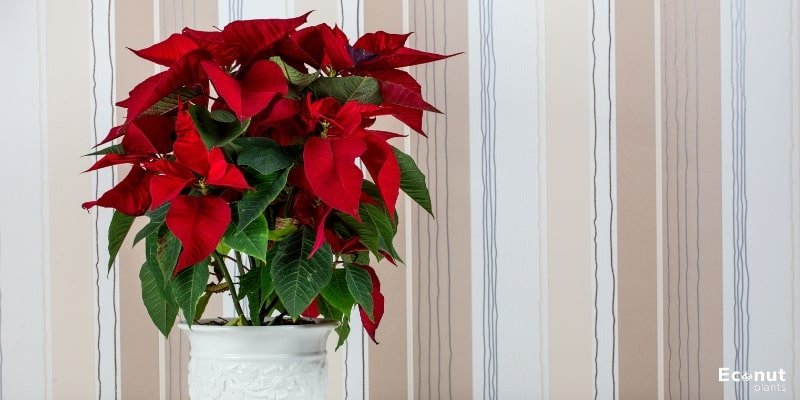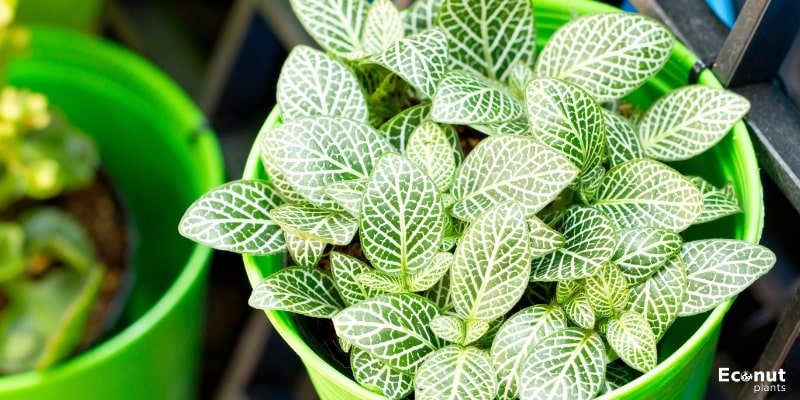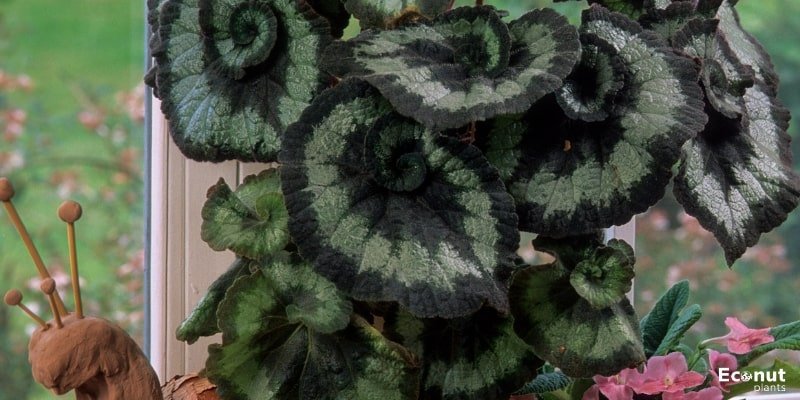Bright Indoor Plants to add some variation to your interior when you’re itching for something new. The foliage on these exquisite indoor plants displays a rainbow of hues all year, ranging from red and pink to nearly black plants.
Plus, the majorities requires little upkeep and are simple to maintain, so you can add some colour to almost any room that has a window that faces the sun. These 20 bright houseplants can be used as interior décor.
1. Anthurium
 Scientific Name: Anthurium andraeanum
Scientific Name: Anthurium andraeanum
Plant Type: Herbaceous plants
Plant Size: 16 inches tall
Sun Exposure: Part Shade
The unique colours of waxy spathes have led to the resurgence of this ancient plant in recent years. Bright, flat colour are found in certain anthuriums, while intriguing patterns are found in others that combine many colours.
Moreover, they are epiphytes that were transported into homes to create low-maintenance houseplants from tropical jungles in South America.
These plants have a small hibernation in the winter and can bloom continuously if well-cared for. Heart-shaped leaves enveloping each bloom provide even more decorative value, and each bloom lasts for two to three months.
2. Prayer Plant
 Scientific Name: Maranta leuconeura
Scientific Name: Maranta leuconeura
Plant Type: Herbaceous, perennial
Plant Size: 12 inches tall
Sun Exposure: Part Shade
Officially named Maranta leuconeura, the prayer plant will add colour to your house with its vividly striped leaves that contrast with a rich emerald green, showcasing yellow and red areas.
Create an atmosphere that is warm and humid, with moist soil and indirect light, just like the prayer plant’s native Brazil.
3. Croton
 Scientific Name: Codiaeum variegatum
Scientific Name: Codiaeum variegatum
Plant Type: Evergreen shrub
Plant Size: 4-10 feet
Sun Exposure: Full sun, partial shade
These indoor plants, also known as garden croton, have brightly mottled leaves that can be a mixture of green, yellow, orange, and/or red.
If you still feel like you need more colour, there are also uncommon variants that have some pink and purple mixed in as well. Additionally, there are a variety of leaf forms available, so you can almost always find a leaf shape and colour combination that appeals to you.
Croton thrives well in some direct sunshine, which will result in better leaf colour than most other plants on this list.
In order to promote growth, keep the soil around the croton damp but not wet. This beauty may grow up to six feet tall and five feet wide with the right care, so be sure you have what it takes.
4. African Violet
 Scientific Name: Saintpaulia ionantha
Scientific Name: Saintpaulia ionantha
Plant Type: Semi-succulent
Plant Size: 3-6 inches
Sun Exposure: Partial shade
African violets are anything but delicate, despite their appearance. Favourite houseplants that can withstand a dusty corner and the odd watering will thrive with proper maintenance. They have stunning flowers in violet, purple, pink, and white hues, as well as wonderful, fluffy foliage.
Found growing between rocks and sheltered by trees in Tanzania’s and Kenya’s cooler mountainous regions, the original Saintpaulia species is still present.
They are perfect houseplants for a variety of reasons, including this one. The genus Streptocarpus currently includes the numerous hybrids of these unique plants that are available everywhere.
For the majority of the year, African violets bloom, providing a necessary burst of colour during the colder months. You can also take pleasure in the year-round beauty of the fuzzy foliage as long as you water from the bottom to prevent putting drips on the leaves.
5. Christmas Cactus
 Scientific Name: Schlumbergera
Scientific Name: Schlumbergera
Plant Type: Succulent
Plant Size: 6-12 inches
Sun Exposure: Indirect light
Do you want to add something wonderful to your wintertime indoor garden? We advise you to choose Christmas cacti, which have a very classic vibe. They will undoubtedly enhance your amazing indoor landscape.
Typically blooming in the winter, these houseplants need strong, indirect sunlight to grow. Everybody’s favourite plants are those with pastel flowers, such as lilac, pink, and red.
6. Chinese Evergreen
 Scientific Name: Aglaonem
Scientific Name: Aglaonem
Plant Type: Herbaceous perennial
Plant Size: 1-3 feet
Sun Exposure: Indirect light
The Chinese Evergreen, also known as Aglaonema, is an excellent choice if you’re seeking a trouble-free houseplant, as long as you provide the right growing conditions.
It merely requires low to bright indirect sunshine and occasional watering every five to ten days. There are variations, with vivid stripes ranging from red to silver on green foliage.
7. Cyclamen
 Scientific Name: Cyclamen persicum
Scientific Name: Cyclamen persicum
Plant Type: Tuberous perennial
Plant Size: 6-16 inches
Sun Exposure: Indirect light
According to Mast, cyclamen are a blooming houseplant that is simple to maintain and may produce vibrant, heart-shaped blooms that, under the correct circumstances, can last up to eight weeks.
“Keep the soil moist, and make sure there is no standing water in the pot,” she states. “Some varieties have sweetly scented blooms.”
8. Polka dot plant
 Scientific Name: Hypoestes phyllostachya
Scientific Name: Hypoestes phyllostachya
Plant Type: Herbaceous perennial, shrub
Plant Size: 30 inches
Sun Exposure: Full Sun, Indirect light
According to Leisure Bench’s garden expert Steve Chilton, “These plants have beautifully coloured speckle leaves in shades of pink, red, white, or green that make a change from the plain green that we’re so used to with houseplants.”
This writer can only agree, having a polka-dot plant of her own. This fascinating plant not only adds design but also colour to interior spaces.
A bright location with indirect sunlight or some shade is ideal for polka-dot plants. Maintain a constant moisture level in the soil, but don’t water it excessively to prevent water logging.
9. Orchid
 Scientific Name: Phalaenopsis
Scientific Name: Phalaenopsis
Plant Type: Monocotyledonous flowering plant
Plant Size: 30 inches
Sun Exposure: Indirect sunlight
Supermarkets usually have them, and they make wonderful gifts. Even in the bitterest winter, they are able to bloom annually. It is best for these plants to be in bright, indirect light.
So that they receive the right amount and quality of light to grow, think about positioning them close to a south- or east-facing window in your living room. With their ability to both release and absorb carbon dioxide, orchids are especially helpful in bedrooms, as they help to maintain fresh, clean air in your sleeping space.
10. Calathea
 Scientific Name: Calathea
Scientific Name: Calathea
Plant Type: Herbaceous perennial
Plant Size: feet
Sun Exposure: Bright, indirect sunlight
The geometric patterns on caleathea leaves can include stripes, splotches, dots, or shading in shades of light and dark green with accents of red, purple, or white.
These kinds of non-blooming evergreens look great either by themselves or in a grouping with other houseplants that have matching colour schemes.
Calatheas, sometimes known as “prayer plants,” are best suited for warm, humid climates since at night their leaves fold up.
Steer clear of direct sunlight, as it will bleach their lovely leaves. Rather, give them indirect lighting and make sure their soil stays damp but not drenched.
11. Poinsettia
 Scientific Name: Euphorbia pulcherrima
Scientific Name: Euphorbia pulcherrima
Plant Type: Shrubs, Small trees
Plant Size: 2-13 feet
Sun Exposure: Indirect sunlight
The small golden blooms in the center of the poinsettia are the real flowers. Actually, the red “petals” are called bracts. Although they are a Christmas season mainstay, poinsettias may continue to brighten your home even after the New Year.
12. Rubber Plant
 Scientific Name: Ficus elastica
Scientific Name: Ficus elastica
Plant Type: Perennial
Plant Size: 6-10 feet
Sun Exposure: Indirect sunlight
Rubber plants have glossy, oblong leaves that are dark green or maroon in colour. Variegated rubber plants have spots of yellow, cream, pink, and white on their leaf. Because of its low care requirements, it’s perfect for novices.
13. Nerve Plant
 Scientific Name: Fittonia albivenis
Scientific Name: Fittonia albivenis
Plant Type: Tropical houseplant
Plant Size: 3-6 Inches
Sun Exposure: Low to medium light
The characteristic feathery veins of these plants are well known. While white is the most popular colour, other hues are also available; the pale pink variation is very lovely.
Terrariums are a good home for these humidity-loving plants because they require continuous watering and shouldn’t ever dry up. Additionally, they dislike direct sunshine, and too much of it will cause their leaves to brown.
14. Streptocarpus
 Scientific Name: Streptocarpus
Scientific Name: Streptocarpus
Plant Type: Herbaceous perennial
Plant Size: 1-2 feet
Sun Exposure: Bright shade, Partial sun
Beautiful flowers bloom from spring to fall on these hardy plants, which also have huge, fluffy leaves. Big trumpet blooms with black stripes flowing from the centers are available in white, red, lilac, and pink hues.
Growing in patches of shade along rivers and forests, they are generally known as Cape Primrose and are native to the South African coast. Though it will yield more blossoms in strong light, streptocarpus makes excellent houseplants in situations where an abundance of light is a concern.
Being overwatered bothers them, which implies they are not in the least bit dependent. Amazing colour selections are available in some of the new hybrids, which will bloom all year. Streptocarpuses are valuable additions because, even in their dormant state, they have attractive leaves.
15. Pink Princess Philodendron
 Scientific Name: Philodendron erubescens
Scientific Name: Philodendron erubescens
Plant Type: Perennial
Plant Size: 4 feet
Sun Exposure: Indirect sunlight
The sheer variety of philodendrons makes them one of our favourite plants. Furthermore, they provide care that is largely delegative. This one has a beautiful pink colour, but since it’s not very common, a tiny pot might cost more.
16. Caladium
 Scientific Name: Caladium
Scientific Name: Caladium
Plant Type: Tropical perennials
Plant Size: 12-30 Inches
Sun Exposure: Full sun, Partial shade
The heart-shaped foliage of the caladiums has eye-catching lines and spots that will definitely make your area stand out! Its pattern bursts with colour, giving the impression that it was created by an artist on canvas.
17. Purple Shamrock
 Scientific Name: Oxalis triangularis
Scientific Name: Oxalis triangularis
Plant Type: Perennial
Plant Size: 6-12 Inches
Sun Exposure: Full sun, Partial shade
The trifoliate leaves with their dark-coloured leaflets resemble little butterflies, whose “wings” close at dusk and unfold again at dawn.
Purple shamrock is a shade plant outside but may be grown indoors in bright indirect light. In spring, prune the plant if it turns lanky throughout the winter to promote fresh growth.
18. Begonia
 Scientific Name: Begonia
Scientific Name: Begonia
Plant Type: Perennial flower
Plant Size: 6-12 Inches
Sun Exposure: Partial shade
Given their wide variety of colours, begonias are among the most well-liked plants. That does not imply, however, that they are difficult to take care of.
Begonias have a succulent stem that acts as a natural water reservoir throughout the dry months of the year. Pets may become poisoned by them.
19. Coleus
 Scientific Name: Coleus
Scientific Name: Coleus
Plant Type: Herbaceous perennial
Plant Size: 1-3 feet
Sun Exposure: Full Sun
Recall that I mentioned that the croton plant is unquestionably the most colourful member of the family of houseplants. Unless you happen upon a coleus, that is.
Then you should remove Croton’s crown and dethrone it. Picking favourites should take into account the fact that coleus is slightly more picky than croton.
20. Peace Lily
 Scientific Name: Spathiphyllum
Scientific Name: Spathiphyllum
Plant Type: Flowering plants
Plant Size: 1-3 feet
Sun Exposure: Bright, indirect light
Spathiphyllum, or peace lilies, are a great choice for people who frequently overwater their plants. Not to mention that the air-purifying tropical houseplant reduces pollutants.
Their spade-shaped blossoms will flourish over time if you give them enough light. Though there might not be as many blooms, they can withstand low light.

